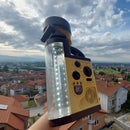Introduction: SSR Latching Circuit With Push Buttons
I’m planning to add some power tools to the underside of my workbench so I can make a table router for example. The tools will mount from the underside on some sort of a removable plate so they can be interchangeable.
If you are interested to see how I built this workbench I have a separate Instructable for it.
Before starting any work on the workbench for the tool mounts I wanted to figure out a way how I can easily turn on and off all of the power tools attached to it as the tool power switches will be under the table.
The easiest solution for it is to mount a power strip on the bench and have its switch exposed so it can be pressed. However, I don’t think that this is a safe option as the cables will also be exposed and I could accidentally turn on the switch.
An off the shelf solution is to buy one of these commercially-made safety switches but I have two problems with that.
The first problem for me is that they are not available locally where I live and I can’t order one online at the moment and the second problem is that they are quite expensive so the decision is made to build my own.
Supplies
Tools and materials needed to make this project:
- Soldering iron - https://s.click.aliexpress.com/e/_d8xmmf7
- Assorted resistors - http://s.click.aliexpress.com/e/_dSIvhPF
- Solid State Relay - http://s.click.aliexpress.com/e/_dTmBlfa
- Industrial On/Off Power Switch - http://s.click.aliexpress.com/e/_d6QWARW
- Assorted transistors (2N2907 & 2N2222) - http://s.click.aliexpress.com/e/_dZ7W6Yu
- Prototype PCBs - http://s.click.aliexpress.com/e/_dVZ8c6U
Step 1: The Relay
To control the power tools, I’ll use this solid state relay that is rated for 25A and it should be more than enough. In theory, this SSR can switch up to 6KW on 240V of resistive load. To protect your SSR, it is recommended that you never run it above 80% of its maximum so this brings us down to 4.8KW.
Since all of the power tools I’ll be running off this switch include a motor, they are inductive loads and they have a typical power factor of around 0.7 to 0.9 so the theoretical maximum comes down to 3.35KW. My circular saw, for example, is rated for 1.4KW so the relay should turn it on without any issues.
Step 2: The Switch
To control the relay, I have this industrial switch with two terminals but the problem with it is that it is only a momentary switch. As soon as I let go of the contact the circuit is opened and the power tool won’t run. This switch can be wired up with a relay in a latching configuration but the relay I have can only be powered through low voltage DC so that is not an option.
So, to solve my problem I made this simple yet effective circuit that uses two transistors to create a latching switch that can turn its output on and off from a single push of a button.
Step 3: The Circuit
The circuit uses one 2n2907 PNP transistor and one 2n2222 NPN transistor that will work together to create the different states.
At first, both of them are turned off and current is not flowing. The base of the PNP transistor is kept high and the base of the NPN is kept at low voltage.
As soon as we press the ON button, we apply higher voltage to the base of the NPN transistor and this turns it on. Now the current starts flowing and a voltage drop is created on the output, in this case on the LED and its resistor, and this technically brings the base of the PNP transistor low so it starts conducting.
Because of the configuration that they are in, this now brings the base of the NPN transistor at high voltage and we can let go of the switch and the circuit will still operate and have its output across the LED and its resistor turned on.
To turn it off, we can now press on the second, off switch, and with that, we will bring the base of the PNP transistor high and it will stop conducting. This lowers the voltage on the NPN transistor base as it is now pulled to ground through the resistors and it turns off as well, cutting the current flow on the output.
Step 4: Transfer the Circuit to PCB
Once I was happy with the circuit design, I created a PCB layout in EasyEDA, and based on it I transferred the circuit to a prototype board with 4, 2 pole screw terminals to later connect the power supply, the two switches, and the SSR onto them.
Step 5: Test the Circuit
A final inspection confirmed that the circuit is running as expected so I can declare it as done for now. With the electronics out of the way, the next step will be to figure out how and where to mount it on the bench so if you have any placement suggestions feel free to let me know in the comments.
Step 6: Next Steps
My current plan is to either mount it on the left leg of the workbench or to add another piece somewhere in the center so the switch is accessible with my right hand. As I said, let me know your thoughts on this and be sure to like, subscribe to my YouTube channel and hit the notification bell so you don’t miss the second video where I install this to the bench and add a safety paddle on top of it.
Cheers and thanks for following along.











